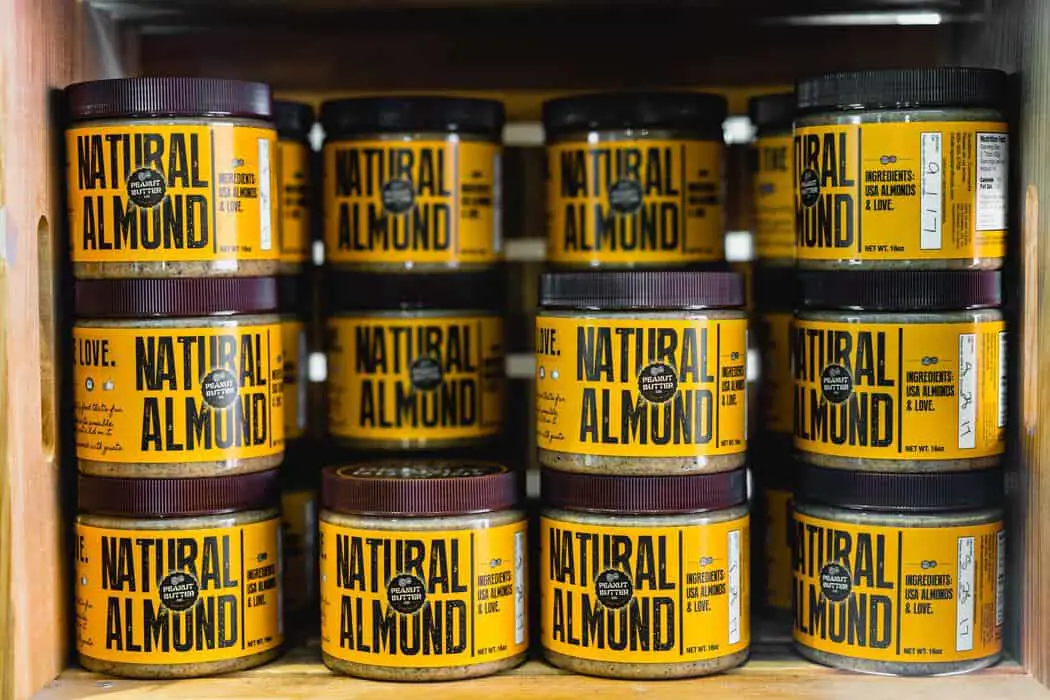One of the cornerstones of the keto diet is heavying up on healthy fats.
A problem a lot of new keto dieters face is not knowing exactly where to find these fats, as most Americans were sold the lie that fat is something that they should stay away from.
Obviously the best way to get fat adapted for ketosis is to consume healthy fats in pretty large proportions, but that doesn’t mean you have to just eat butter and avocados all day.
Almond butter is a great source of healthy fat, and is one of the most versatile foods that I’ve found for different types of recipes.
In this post, I’ll explain the exact nutrient breakdown of almond butter, how it can be effectively used on a keto diet, and provide some of my favorite keto-friendly almond butter recipes.
What Is Almond Butter
On its own, almond butter is generally a pretty safe and unprocessed food. If you’re familiar with peanut butter, almond butter is derived in a pretty similar way, but instead of coming from peanuts, it comes from almonds.
Almonds are a type of tree nut, and they come with all of the same benefits and drawbacks as most other tree nuts that you’ll find. From a nutrition perspective, almond butter tends to have the following average breakdown per 2-tablespoon serving:
- Calories – 101
- Carbs – 3.4 grams
- Fiber 0.6 grams (sugar varies by brand)
- Fat – 9.5 grams (predominantly monounsaturated fats, high in Omega-3 fatty acids)
- Protein – 2.4 grams
Almond butter is also a pretty big host of essential vitamins and minerals that you’ll want in your daily diet. Some of the most prominent ones include:
- Vitamin E
- Calcium
- Iron
- Riboflavin
- Niacin
- Copper
- Choline
- Selenium
- Phosphorus
- Magnesium
- Potassium
- Zinc
- Folate
- Manganese
Compared to peanut butter, almond butter has roughly twice the amount of iron, three times the amount of vitamin E, and a whopping 7 times the amount of calcium, making it an extremely nutrient-dense way to enhance most meals on any diet.
One of the best things about almond butter is that like peanut butter, it’s an extremely versatile food. Almond butter can be used on its own, spread on other foods like vegetables and low carb snacks, and it’s very heat stable so it can be used in smoothies and shakes, salad dressings and stir fries, as well as baked goods like fat bombs, cookies, and other types of sweets.
Is Almond Butter Keto-Friendly?
Because of the macronutrient breakdown of almond butter, it’s absolutely keto-friendly. Almond butter is low in carbs, and high in healthy fats and proteins, making it a great snack choice for a low carb lifestyle.
You’ll of course have to keep an eye on the specific brand of almond butter when following a keto diet, because some do tend to be high in sugar from time to time, which can obviously be pretty bad for maintaining a state of ketosis. A good rule of thumb is to aim for an almond butter brand that has no more than 3 grams of net carbs per serving, where you’ll want to see fiber maximized and sugar minimized wherever possible.
Furthermore, almonds aren’t necessarily some of the best nuts on the keto diet, such as walnuts, pecans, brazil nuts, and macadamia nuts for their nutrient breakdowns, but almond butter is cheap, keto-friendly, and tastes great.
Another reason I like to use almond butter is because of all the added benefits that come with it on top of the significant amount of nutrients that it provides. You can check out some of the most game changing benefits I’ve noticed below.
Benefits of Almond Butter
-
Lower carbs than peanut butter
One of the reasons a lot of people opt to use almond butter over peanut butter is both because it has lower calories, and more importantly for keto, because it has much lower net carbs on average.
Carbohydrate amounts in peanut butter can get a little high, with some reaching even 6 or 7 per two tablespoons, compared to 2-4 net carbs in most servings of almond butter. While both are fine in moderation on the keto diet, almond butter’s much better for light snacking and for making fat bombs that require a lot of it in each serving. Almond butter is also rich in fiber, and tends to have less preservatives and sugars or sweeteners than a lot of typical peanut butter brands might have.
-
Good source of healthy fats
Almond butter, like peanut butter, is a great source of omega-3 fatty acids, which is the exact type you’ll want a lot of when hitting your fat macros on the keto diet.
While peanut butter is known to have more fat in general than almond butter, almond butter tends to have more of the type of fat that you want – monounsaturated omega-3 fatty acids. Looking into the nutrition facts of each, you’ll see that on average a 2-tablespoon serving of almond butter contains roughly 25 percent more monounsaturated fat than the same amount of peanut butter
-
Can stabilize insulin and blood sugar levels
Almonds are often recommended by doctors as ways to help diabetics manage their insulin levels due to the high amounts of magnesium and fiber that they contain. This property can lend itself to helping with the ketogenic diet as well.
Recent research has shown that almonds have been linked to being able to reduce the rise of both blood glucose (blood sugar) and insulin levels after meals. Almond consumption has also been shown to help improve insulin stabilization in those who were diagnosed with prediabetes.
-
Can help contribute to weight loss
Because almond butter is naturally high in healthy omega-3 fatty acids and has been proven to help with leveling out insulin levels, it is a great support for maintaining a healthy weight and even working toward weight loss.
One recent study researched two different diets over the course of a 6-month timespan. One group was provided a strict low-fat and low-calorie diet with only 18% of their overall daily calories containing fat. The second group followed a much higher fat diet with at least 39% of calories coming from fat (largely from almonds and almond butter) while they maintained the same amount of calorie intake as the first group.
Not only did the second group of people end up losing more weight during a 6 month period, they also lost significantly more weight around their waistline and stomach than the other group.
-
High in magnesium
Almond butter is high in magnesium, which is an essential nutrient and electrolyte that your body needs a lot more of while in a state of ketosis.
Magnesium also plays a vital role in supporting the body’s metabolism. Additionally, magnesium has been known to help stabilize blood sugar levels and prevent spikes in blood pressure levels. At a nutrient level, almond butter contains roughly 90 mg of magnesium in just two tablespoons, which is about 25% of the recommended daily amount that most adults need.
Side Effects of Almond Butter
-
Contains less selenium than peanut butter
Peanut butter is a pretty big provider of selenium, which is an important nutrient that helps with our enzyme functioning for digestion. Almond butter on the other hand contains far less selenium than peanut butter, to a fairly negligibly beneficial degree.
This means that if you were to replace your intake of peanut butter entirely with almond butter, you’d be losing out on a lot of selenium that can help promote good digestion, protect against thyroid problems, and promote natural energy boosts.
There’s always the option of supplementing your diet with selenium supplements (I get mine on sale over at Amazon.com), but it’s a lot easier to just have a nice balance of almond and peanut butter on a keto diet.
-
Can be expensive
One reason a lot of people don’t opt to purchase almond butter is simply because it’s a lot more expensive than peanut butter. This doesn’t always have to be the case, if you know where to look however. There are tons of cheap options on the market, and if your grocery store doesn’t have any affordable options, keto-friendly and low cost almond butter options are fortunately easy to find online too. Amazon for example has a great brand called , Zinke Orchards, which is usually on sale.
One thing to keep an eye on is carb counts, going for cheaper options can sometimes land you with almond butters that have less fiber, and are therefore higher in net carbs, so you’ll always want to pay attention to the nutrition facts.
-
High in oxalates
Almonds are naturally high in oxalates. Oxalate, otherwise known as oxalic acid, is a naturally-occurring and reactive molecular substance that can be found in a multitude of other types of foods that come from plants, such as tree nuts and certain seeds, as well as fruits and even chocolate.
Most people’s bodies have a very good natural system to deal with oxalates, and while they’re not great for anyone, the majority of people experience no negative symptoms from consuming them. However those with tree nut allergies or poor gut bacteria might have a harder time, and too many oxalates can lead to unwanted symptoms like indigestion, bloating, nausea, and excessive sweating.
-
Allergies
Like peanuts, almonds are a common form of allergies, particularly for those who have problems with tree nuts. The primary symptoms of almond related allergies include breaking out in hives around the surface of the skin, respiratory and gastrointestinal issues, and full blown anaphylaxis, which is definitely the most dangerous type of allergic reaction that you could possibly have.
If you suspect you may have a tree nut allergy, it’s advised to check with a doctor before purchasing or consuming any products that contain almond butter.
-
Can still have excessive amounts of sugar
One issue with pre-packaged and processed foods is a lot of them tend to come with sugar, or even non-sugar (but still harmful) sweeteners like dextrose and maltodextrin. If your almond butter isn’t organic (typically, the kind you need to stir or mix before eating), you’ll want to keep a close eye on its nutrition facts to check for sugars or blood-sugar effecting sweeteners, as well as fiber and overall net carb counts.
Keto-Friendly Almond Butter Recipes
-
Almond Butter Brownie Cookies

These are great for when you just need to get your chocolate fix, and go great with a nice cold glass of almond milk on the side. The ingredients are pretty easy and cheap:
-
- 3 tablespoons of vanilla almond milk, unsweetened if needed
- 1/4 cup of Lily’s sugar-free chocolate chips
- 4 tablespoons of cocoa powder unsweetened
- 1 cup of smooth almond butter
- 1/2 cup of granulated sweetener. I like using Lakanto Monk Fruit Sweetener
- 1 large egg
To make these, just follow these easy steps:
-
- Preheat your oven to 350 degrees Fahrenheit
- In a bowl, mix the cocoa powder, almond butter, sweetener, and the egg with a fork until well-combined
- Add up to 3 tablespoons of almond milk to help smooth out the mixture if it is too crumbly. The batter should look fudgy and soft when combined.
- Stir in the chocolate chips
- Roll balls of the mixture with your hands and press them down on a baking pan that is lined with parchment paper
- Bake the cookies for 10-12 minutes until the tops of the cookies begin to show little cracks in them.
- Serve warm with some nice cold keto-friendly almond milk!
-
Chocolate Almond Butter Smoothie

This one’s great for those who have been missing out on milkshakes on the keto diet. While it’s technically more of a smoothie, it definitely will be able to fight off those sweet tooth cravings and keep you full for hours, all while being a great source of vital nutrients. The ingredients include:
-
- 1/2 of an avocado
- 1 cup of unsweetened vanilla almond milk
- 2 tablespoons of almond butter
- 1 cup of ice cubes
- 1 tablespoon of cocoa powder (100%, unsweeted)
- 1/8 ounce of chia seeds
- 7 drops of stevia liquid for sweetening
From there, the directions are fairly simple. You’ll just want to combine all of the ingredients together in a blender, except for the avocado. You’ll want to start the blender on slow until the level goes down, and then add the avocado and turn the blender on your preferred setting (mid to high). Serve cold, and that’s it!
-
Low Carb Almond Butter Fudge (Fat Bombs)
For me, quitting chocolates and fudges was one of the most challenging parts of starting a ketogenic diet. However over time, I learned that there are low carb ways around them to help satisfy those cravings, and almond butter fudge is one of my favorite recipes to do that.
The total time it takes to prepare is pretty quick, and this can yield around 8-13 servings. They work as great fat bombs in my opinion too. Ingredients include:
-
- Half a cup of almond butter
- 2 and a half tablespoons of virgin coconut oil
- 2 ad a half tablespoons of liquid stevia (or a sweetener of choice, monk fruit syrup works great here too)
- A few drops of maple extract
The directions are also pretty simple too:
-
- Combine the almond butter and coconut oil, and gently warm until the nut butter is easily stir-able and the coconut oil is turned into liquid.
- Stir in the sweetener if desired, then spoon the mixture into a plastic container or candy molds.
- Freeze the mixture for a few hours until solid, and store leftovers in the freezer.
- Serve chilled
The macros for this one are as follows (1 piece per serving):
-
- 88 calories
- 7.4 grams of fat
- 4.3 grams of carbohydrates (1 gram of fiber)
- 2 grams of protein


